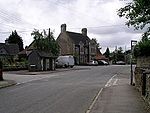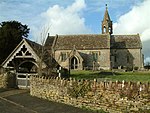Stanton St Quintin
Civil parishes in WiltshireEngvarB from August 2019OpenDomesdayVillages in Wiltshire

Stanton St Quintin is a small village and civil parish in the county of Wiltshire in England. It is about 4 miles (6.4 km) north of Chippenham and 5 miles (8.0 km) south of Malmesbury. The parish church dates in part from the 12th century. The parish includes the hamlets of Clanville (in the southeast) and Lower Stanton St Quintin (on the A429 road, 0.6 miles (0.97 km) to the northeast).
Excerpt from the Wikipedia article Stanton St Quintin (License: CC BY-SA 3.0, Authors, Images).Stanton St Quintin
Bouverie Park,
Geographical coordinates (GPS) Address Phone number Website Nearby Places Show on map
Geographical coordinates (GPS)
| Latitude | Longitude |
|---|---|
| N 51.518 ° | E -2.136 ° |
Address
Stanton St Quintin Primary and Nursery School
Bouverie Park
SN14 6DQ , Stanton St. Quintin
England, United Kingdom
Open on Google Maps








